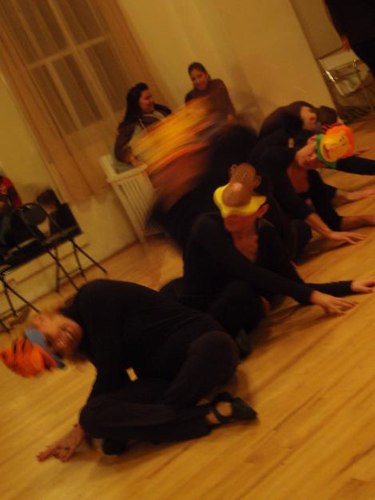|
 |
|
|
 |
 |
On Sunday, December 15, Dance Times Square studio in midtown held an in-house competition for its students, an event that the studio organizes about once per year. Around twenty students participated and the competition, which lasted about three hours, was divided into 100 heats, or rounds, about three-quarters of those measuring proficiency in the Latin dances (Cha Cha, Samba, Rumba, Paso Doble, and Jive), in which the studio specializes, with the remainder in Standard Ballroom (Waltz, Foxtrot, Tango, Viennese Waltz, and Quickstep), and even a few heats devoted to such social dances as Hustle, Salsa, and Merengue. Each heat included about three or four competitors dancing at one of several levels: Bronze (beginner), Silver (intermediate), Gold (advanced), or Open Gold (highest level, with choreography that does not have to stick to the official syllabus). This in-house competition, the only one of its kind in New York, is meant to simulate a real pro/am championship (in which students dance with their professional instructors), and gives competition-bound students the unique opportunity to experience a small-scale championship in a non-stressful, friendly environment before they take to the floor when it really counts. (Friends and family are welcome to come and cheer them on; spectator fees are $15.) Studio co-owner, Melanie LaPatin, acted as emcee, announcing the heats and calling out competitor numbers. The judges were Vibeke Toft, Edward Simon, and John Nyemchek, all real arbiters at several local and national competitions. From these judges, however, the students actually get more than they would in a real competition: the judges give each student a detailed written evaluation listing their strengths and weaknesses, which helps them to improve problem spots. "Oh that's the whole reason why I do this," said student Elaine Warshaw, "so I can get all that feedback. And these are top-level judges, so what they think is important." The judges give students advice on both technique and stylistic issues, according to Ms. Warshaw, who, last competition, was told, among other things that she needed to keep her head and eyes up more. And the judges took their roles very seriously on Saturday. They recalled heats and asked for more dance time if one of them did not have a chance to watch each dancer adequately, running the competition into overtime. Overall, I was very impressed with teacher Michael Choi's students, both at the beginner and more advanced levels. Ms. Warshaw, who takes Standard Ballroom lessons with Mr. Choi, told me he is a very serious instructor, letting "nothing slip by." It shows. Topping off the event was a new category the studio added this year: a team competition, which was by far the least serious and most fun part of the night. Every student who competed individually was able participate in one of three groups, each coached by a pair of instructors. "The Cats and Dogs" were led by Frederic Havez and Lauren Schelfhaudt; "The Lions and Tigers," by Michael Choi and Magdalena Piekarz; and "The Monkeys," by Jacob Jason and Tess Murphy. Each team sent one couple at a time to compete in several Latin and Ballroom dances, then danced a raucous group number organized around a theme and using open choreography from a variety of dances. "The Cats and Dogs" danced to popular, hip hop song "Who Let the Dogs Out," "The Lions and Tigers" to "The Lion Sleeps Tonight" from "The Lion King," and "The Monkeys" to "Hey, Hey, We're The Monkeys." The team competition is a crowd favorite each year at Blackpool, the largest ballroom competition in the world, where the contest is between four countries, and it was a very cute addition here. Afterwards, there was a big pizza party and social dancing until late into the night.
 Students competing. Photo © & courtesy of Tonya Plank |
|
 "The Lions and Tigers" group team number. Photo © & courtesy of Tonya Plank |
|
 Instructor Jacob Jason dancing with a student. Photo © & courtesy of Tonya Plank |
|
|
|




